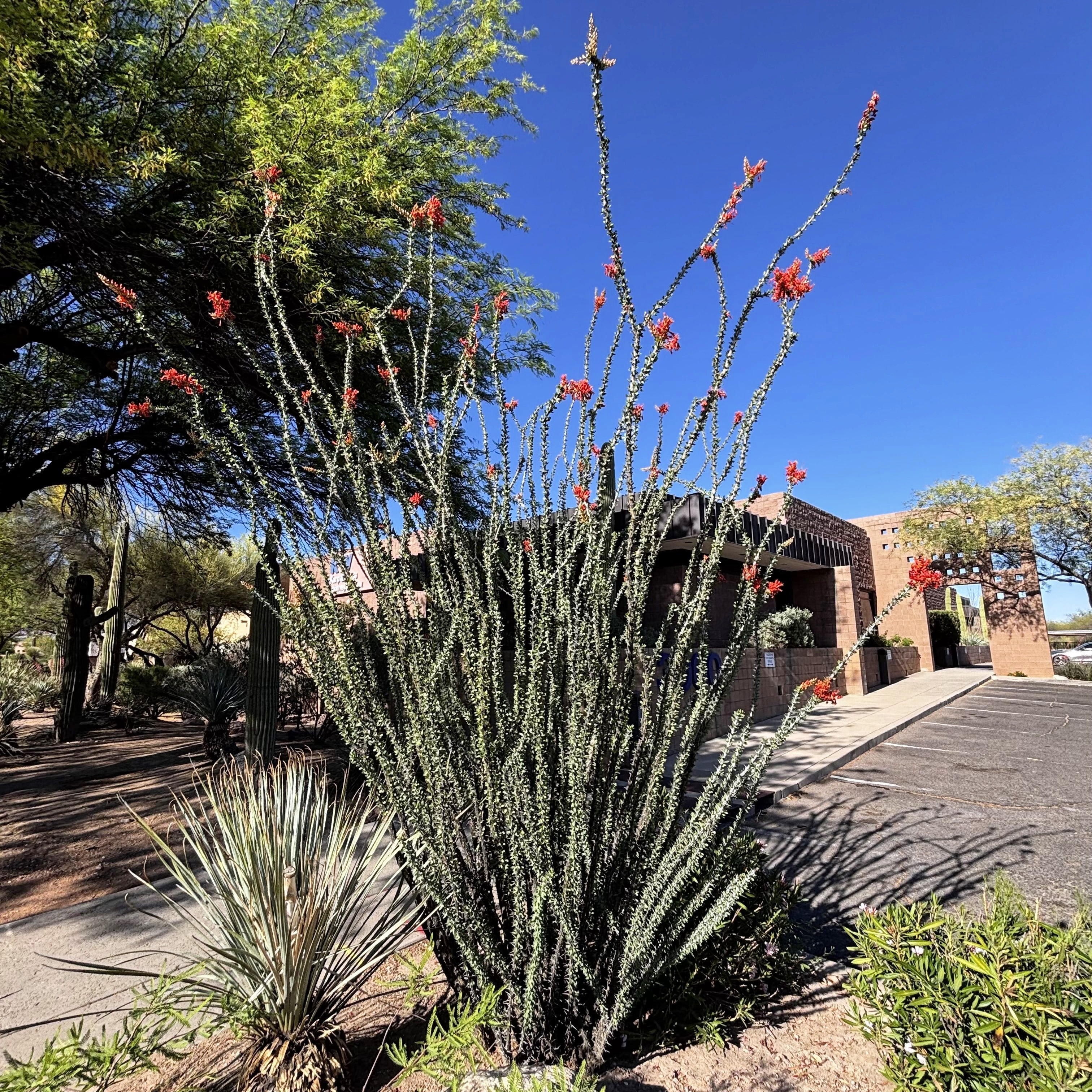🌵 Ocotillos: The Resilient Torch of the Desert
Ocotillos (Fouquieria splendens) are among the most iconic and resilient plants of the American Southwest. With their tall, spiny stems and vivid red flowers, they embody the spirit of the desert—thriving in harsh conditions, adapting to seasonal rhythms, and supporting a host of wildlife. In this comprehensive guide, we'll explore their native habitat, growth cycles, floral displays, cold tolerance, and care requirements. We'll also introduce other members of the Fouquieria genus.
🌵 Native Habitat and Ecological Range
Ocotillos are native to the deserts of the southwestern United States and northwestern Mexico. Their range spans the Mojave, Sonoran, Chihuahuan, and Colorado deserts, encompassing areas from southern California and Nevada to Arizona, New Mexico, Texas, and into Mexico as far south as Hidalgo and Guerrero.
In their native habitats, ocotillos are typically found on dry, well-drained rocky slopes, mesas, outwash plains, and desert grasslands. They thrive in soils that are shallow, rocky, and often underlain by caliche, a hardened layer of soil . These conditions reflect the ocotillo's adaptation to arid environments, where water conservation is paramount.
🌿 Growth Cycles and Leaf Behavior
Ocotillos are drought-deciduous shrubs, meaning they shed their leaves during dry periods to conserve water. Their stems are green and photosynthetic, allowing them to continue producing energy even when leafless. After rainfall, ocotillos rapidly produce small, oval leaves that can grow up to 2 inches long. These leaves remain until the soil dries out, at which point they fall off, and the plant enters a dormant, leafless state.
This leafing and defoliation cycle can occur multiple times a year, depending on rainfall. In southern Arizona, for example, ocotillos may bloom from March to May, with flowering lasting 50 to 60 days.
🌺 Floral Displays and Pollination
One of the most striking features of ocotillos is their vibrant floral displays. Bright red, tubular flowers appear at the tips of their stems, forming clusters that resemble torches—hence the name "ocotillo," which means "little torch" in Spanish. These flowers are typically 1/2 to 1 inch in length and bloom from March through June, depending on rainfall.
Ocotillo flowers are pollinated by hummingbirds, which are attracted to the nectar-rich blooms. In southern Arizona, the timing of ocotillo flowering coincides with the northern migration of hummingbirds, providing a crucial food source during their journey.
❄️ Cold Tolerance and Hardiness
Ocotillos are well-adapted to the desert's extreme temperatures. They are hardy in USDA zones 7a to 11b, tolerating temperatures as low as 5°F (-12°C) once established . This cold tolerance makes them suitable for cultivation in areas like Phoenix and Tucson, Arizona.
However, ocotillos are not frost-tolerant. In colder climates, they may require protection during winter months to prevent damage. It's important to note that ocotillos are adapted to the dry heat of the desert and may struggle in areas with high humidity or excessive rainfall.
🌱 Caring for Ocotillos
🌞 Light and Soil Requirements
Ocotillos thrive in full sun and require well-draining soil. They are best suited to rocky, sandy, or gravelly soils, similar to their native desert habitats. Good drainage is essential to prevent root rot, a common issue in poorly drained soils.
💧 Watering and Fertilization
Once established, ocotillos are highly drought-tolerant and require minimal watering. Overwatering can lead to root rot, so it's crucial to allow the soil to dry out between waterings. Fertilization is generally not necessary, but a light application of a balanced fertilizer in early spring can promote healthy growth.
✂️ Pruning and Maintenance
Ocotillos require little maintenance. Pruning is typically only necessary to remove dead or damaged stems. When transplanting, it's normal for ocotillos to lose their leaves. They usually re-establish and begin to leaf out within 6-9 months .
🐝 Wildlife and Ecological Benefits
Ocotillos provide significant ecological benefits. Their flowers attract hummingbirds, carpenter bees, and other pollinators, supporting local biodiversity. The plant's structure also offers shelter and nesting sites for various desert species. Additionally, ocotillos are used in traditional landscaping for their aesthetic appeal and as natural fencing due to their spiny stems.
🌿 Other Fouquieria Species
While Fouquieria splendens is the most iconic and widely recognized species in the Fouquieria genus, this group of desert-adapted plants includes around 11 species, all of which exhibit unique traits that make them especially well-suited to arid and semi-arid environments in North America. Members of the genus range from shrubby, low-growing plants to small trees, and they often exhibit unusual growth habits, spine arrangements, and flower structures. Let's explore a few of the notable species in the genus.
🌳 Fouquieria macdougalii (Mexican Ocotillo Tree)
Native to Sonora and northern Sinaloa, Mexico, Fouquieria macdougalii is a more compact and tree-like relative of F. splendens. It typically grows up to 6 feet (1.8 meters) in height and has a slightly bushier appearance, with thicker, more branched stems. Unlike F. splendens, which prefers full sun and extreme aridity, F. macdougalii is often found in slightly more mesic microhabitats within its native range.
Its tubular red to orange flowers are quite similar to those of F. splendens and are also favored by hummingbirds. However, this species is notably less cold-tolerant, making it more difficult to cultivate outside its native range unless grown in frost-free zones.
🌺 Fouquieria formosa
This species is native to the central and southern highlands of Mexico, where it inhabits dry tropical forests and scrublands. F. formosa can grow into a small tree and is distinguished by its unusual branching pattern and beautiful tubular red-orange flowers.
What sets F. formosa apart is its ability to adapt to slightly higher elevations and more moderate moisture levels compared to its desert-dwelling cousins. Its showy blooms attract a variety of pollinators, including hummingbirds and butterflies. Like others in the genus, it is drought-deciduous and produces leaves in response to seasonal rains.
🌿 Fouquieria columnaris (Boojum Tree)
Perhaps the most bizarre and visually striking member of the Fouquieria genus, Fouquieria columnaris, commonly known as the Boojum tree, is native to the Baja California peninsula and a small part of Sonora. This surreal-looking plant resembles something out of a Dr. Seuss illustration, growing up to 50 feet (15 meters) tall with a single, tapering trunk covered in spines and sparse foliage.
Unlike other species in the genus, the Boojum tree tends to grow in slightly cooler, foggy desert climates and is adapted to coastal conditions. It is extremely slow-growing and long-lived, thriving in hyper-arid regions. Its flowers are small, creamy white, and fragrant, appearing during the summer rainy season.
🌱 Fouquieria diguetii (Mexican Ocotillo)
Found throughout Baja California and parts of western mainland Mexico, F. diguetii is sometimes confused with F. splendens due to its tall, spindly stems and red flowers. However, it tends to branch more prolifically from the base and often grows into large, shrubby clumps.
The flowers of F. diguetii are longer and more intensely red, and they typically bloom during the summer monsoon season. This species has found popularity in xeriscaping due to its vibrant blooms and tolerance of poor, rocky soils. It is also important ecologically as a nectar source for hummingbirds and bats.
🌾 Fouquieria fasciculata and Others
Other, less well-known species in the genus include:
-
Fouquieria fasciculata – Endemic to central Mexico; forms thickets with dense branching.
-
Fouquieria shrevei – Found in the Sierra Madre Oriental; grows in limestone-rich soils.
-
Fouquieria ochoterenae – A more tree-like species found in southwestern Mexico; notable for its distinctive bark texture and broad growth habit.
Each species in the Fouquieria genus displays adaptations tailored to its specific environment, but all share the same underlying survival strategy: drought tolerance, water efficiency, and a flowering strategy timed to seasonal rains.




